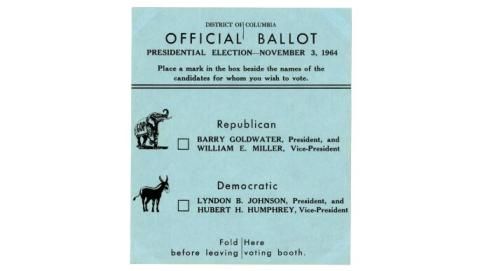
Amendment Twenty-three to the Constitution was ratified on March 29, 1961. It gives electors to the District of Columbia – the capital city of the United States – so that it may participate in presidential elections. The official text is written as such:
The District constituting the seat of Government of the United States shall appoint in such manner as Congress may direct:
A number of electors of President and Vice President equal to the whole number of Senators and Representatives in Congress to which the District would be entitled if it were a State, but in no event more than the least populous State; they shall be in addition to those appointed by the States, but they shall be considered, for the purposes of the election of President and Vice President, to be electors appointed by a State; and they shall meet in the District and perform such duties as provided by the twelfth article of amendment.
The Congress shall have power to enforce this article by appropriate legislation.
According to the Constitution, the Electoral College grants electors only to the states, not to areas considered to be territories or districts. The “district” that would go on to become Washington, D.C. is referred to in Article I, Section 8 as a place where Congress has the authority to govern the area that would become the “Seat of the Government of the United States.” Political advocacy for D.C. having electoral power increased in the early to mid 20th century. In the wake of increased federal authority brought about by the Great Depression and the Second World War, many political groups called for D.C. to have the ability to vote in presidential elections. After a year of deliberation in Congress, Congress combined two separate proposals from the House of Representatives and the Senate to form one proposed amendment that would give D.C. a voice in presidential elections. With the recent admission of both Alaska and Hawaii as states in 1959, the new amendment would need to be approved by thirty-eight states in order to be accepted into the Constitution. The proposal was endorsed by then-President Dwight D. Eisenhower. The ratification process was completed on March 29, 1961, after which the General Services Administration certified the new Twenty-third Amendment.
In the decades following the Twenty-third Amendment, D.C. gained more political autonomy through the Council of the District of Columbia, the governing body in charge of the federal district under the executive rule of Congress. Through the 1970s and 1980s, the political affiliation of D.C.’s voters had shifted from relatively balanced to predominantly Democratic, making the district a near-constantly consistent electoral pool for the party in elections. In more recent years, a movement calling for D.C. to be accepted as a state has emerged. This has been met with divided perspectives and contentious debates. Those in favor of statehood have argued that the Twenty-third Amendment and the 1973 Home Rule Act were precedents for granting the district electoral power, making statehood the next natural progression. Conversely, opponents of granting D.C. statehood argued that it would give the Democratic Party an unfair advantage in elections. Others have observed that the Constitution outlines D.C. as little more than a federal district governed by Congress with the sole intention of being the place where the federal government operates, not as a full-fledged state. Irrespective of the dissenting views and politics surrounding it, the Twenty-third Amendment was significant for reflecting the increasing influences of public advocacy amid the backdrop of 20th century America.